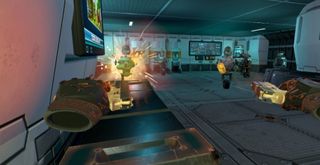'Vindicta' Takes Different Approach To VR First-Person Shooter Locomotion

GDC was ripe with new virtual reality games, and we spent much of the week trying these new experiences. In what could be an emerging trend, we found a first-person shooter that uses a new form of locomotion, and we were shocked when what appeared to be a silly gimmick turned out to be a viable solution for motion sickness and immersive movement in VR.
Vindicta is a new first-person VR shooter developed by Game Cooks, which showcased its work at a special event far from the bustling show floor at Moscone. The company's debut game makes you Agent V, an elite infantry operative tasked with bringing down UB Industries' plan of building a robot army to take over the world. You'll face killer robots, mechanical spiders and a variety of other baddies that will try to thwart your attempts at stopping their evil plot as you cascade down the hallways of the HN1 Facility, taking out the robot trash on your way to save the earth.
Swing Away
The implementation of locomotion in Vindicta is what makes it stand out in the first-person shooter genre, which traditionally has had two prevalent methods of movement. Some use a teleport system, which tends to break the immersion and isn’t well suited for fast-paced map-exploring competitive shooters. The other option is what has been referred to as “classic” locomotion, in which a player simply hits a button on a controller to propel themselves forward (or sometimes, backwards) within the VR environment. The problem with this method is that without a physical action to match what our eyes are seeing, many users can experience nausea.

Vindicta bypasses the brain fart (or brain puke, in some cases) by forcing players to perform a physical action in order to move (strikingly similar to Sprint Vector), essentially syncing the physical signals received by your brain with what you see in the VR environment. The game employs the classic locomotion method (press a button to move) but adds an extra step. The rate at which you walk or run isn’t static; it’s dictated by how far and how fast you swing your arms, creating a more natural feel to movement within a VR environment and making the experience much easier to enjoy, without the need for a bucket.
Vindicta’s movement system isn’t perfect; the demo I played didn’t allow me to walk backwards. In a room-scale environment (in this case, an HTC Vive), it was relatively easy to avoid getting stuck in virtual corners, but I did occasionally have to reorientate myself in order to remain in the real-world play area. This was because I relied more on moving in the physical world while taking out bad guys, only using the push-button locomotion when I needed to travel farther distances. If you were to use the push-button method for the majority of your movements, the lack of backwards thrust could be bothersome, but that’s not the recommended way to travel in Vindicta.
No Stress, No Mess (Well, Maybe A Little)
As someone who suffers from classic locomotion sickness in VR, I was skeptical of the this new method of movement. Before I had an opportunity to try the game, I watched several attendees demo Vindicta. I found myself scoffing at how utterly ridiculous it appeared (some looked as though they were playing air drums while casually walking around, and others were hopping around like a cricket in sunlight and waving their arms wildly), and I started estimating how long I could last without getting sick as I watched the frantic, fast-paced gameplay on the screen.

However, when it was finally my turn (I totally killed it by the way, I'm a regular John Wick), I was shocked at how adding a physical element as simple as swinging your arms arms reduced the nausea factor, which in my case, was entirely eliminated. More importantly, I was able to enjoy the game on a deeper level than if I was worrying about whether or not I was about to upchuck. The only mess that needed to be cleaned up was the mountain of evil robot corpses I left in my wake.
Stay on the Cutting Edge
Join the experts who read Tom's Hardware for the inside track on enthusiast PC tech news — and have for over 25 years. We'll send breaking news and in-depth reviews of CPUs, GPUs, AI, maker hardware and more straight to your inbox.
Our time in the VR world of Vindicta was short, but it was impressive with both its graphics quality and gameplay, in addition to the new locomotion technique. Even though it's still in development, Vindicta has the elements of a game I'd want in my library when it arrives this April as an early access offering for the HTC Vive on SteamVR (pricing TBD).
Most Popular




